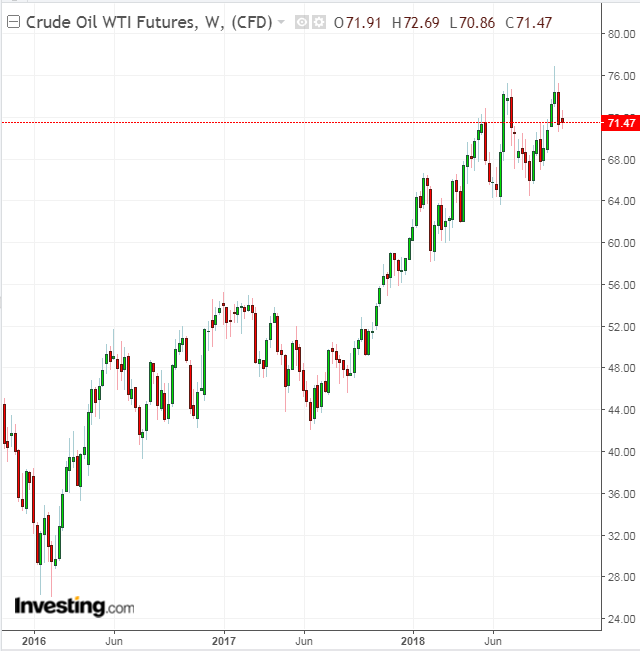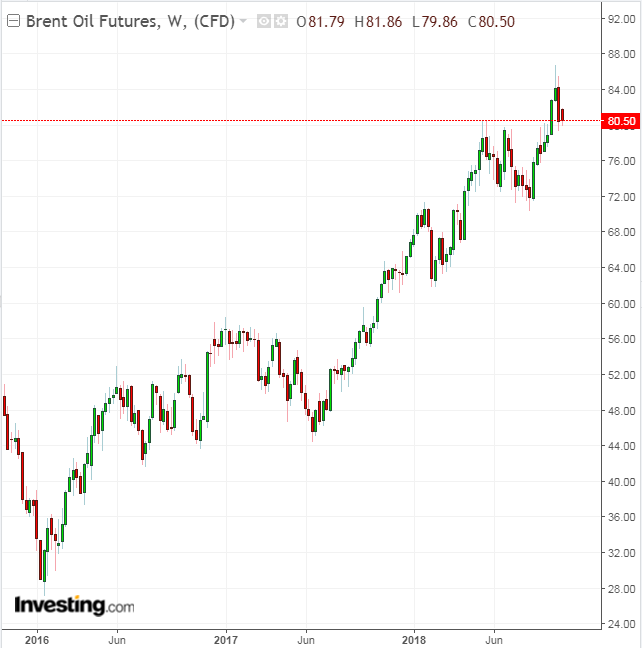Like a tired recording, we've recently been hearing this narrative day in and day out:
“Oil prices are up 40 percent from a year ago, and US sanctions on Iran are largely to blame.”

It's supposed to explain why crude needs to trade higher and not lower. However, there’s another 'slogan' that was in use not too long ago, though it's something we no longer hear:
“Shale has flooded the world with oil and $100 a barrel is history.”
Ever wondered what happened to that? Goldman Sachs may have the answer. The US investment bank, confounded by the same question that has perplexed scores of stakeholders in global energy markets, issued a note last week attempting to unravel “The Road to Shale Tail” phenomenon – which refers to the phase when shale becomes a less meaningful driver of global oil supply.
The October 10 note, lead authored by Goldman’s basic materials equities research expert Brian Singer, said shale has progressed from a “Hopes & Dreams” stage to the “Execution & Efficiency” phase, raising questions of how long it would now remain in the “Tail” stage.
One Million Barrels Per Day Growth Seen
“We are seeing some early signs” of the Shale Tail “but not sufficient to deem shale over,” said Goldman, one of Wall Street’s most influential voices in energy and commodities trading. It added:
“We still see shale as the primary driver of global supply growth, with expectations US oil can continue to grow 1 million bpd/year until 2021 at the earliest.”
Goldman’s view on the endurance of shale is similar to forecasts made by OPEC, the oil cartel comprising Saudi Arabia and other major oil producers.
In a separate note issued three weeks ago, the group, known in full as the Organization of the Petroleum Exporting Countries, said the rise of US shale oil is set to extend well into the 2020s, stealing market share from OPEC.
Shale Threat Seen Through 2023
Total supply from outside of the group will surge by 8.6 million barrels a day from 2017 to 2023, to 66.1 million barrels a day, OPEC said in its World Oil Outlook issued on September 23. The additional output will mainly be increases in US shale production, it added.
The US Energy Administration estimates that crude production in America averaged 11.1 million bpd in September, already above the annual average of 10.7 million bpd estimated for 2018. The total for 2019 is seen at an average of 11.8 million bpd.
At the peak of the global oil glut two years ago, there was an estimated oversupply of 1.5-2.0 million bpd that drove prices from above $100 a barrel to nearly $25 at one point for US West Texas Intermediate crude. But in the past 12 months, global oil markets have been spun on their heads, with the narrative going from too much supply to too little.
And the chorus has been getting louder with each day as we approach November 4: the official start date of the sanctions against Tehran. WTI currently hovers around $71 a barrel while its UK peer Brent trades at around $80.

Both have rebounded with force on the notion that Iran, which exported a peak of 3.5 million bpd in September, could be prevented from shipping some 1.5-2.0 million bpd under the sanctions—the same volume of oversupply once blamed on shale.
Growing Capex A Problem For Shale
According to Goldman, one of shale’s biggest challenges has been growing capital expenditures taxing the resources of US oil drillers—some of them midsized companies trying to survive in a big, global playing field. “The average life span for most transformative areas of global oil supply has been 7-15 years, and shale is now at the lower end of that range (roughly 7 years),” Goldman said.
“The five signals that would tell us we are in Shale Tail are: if inventory is being revised down; well productivity stops improving; supply cost moves higher for secular reasons; capital shifts to other regions; and, ultimately, growth is no longer meaningful.”
Despite some visible signs of supply distress, Singer’s research team concluded that the future of shale was far from over in the US. If anything, shale could reassert itself on the global production scene in the not-too-distant future, the note said—meaning there could be fresh headwinds ahead for oil prices.
“We believe we are potentially still early, not late, in the Execution/Efficiency phase of shale’s life cycle as we continue to see a combination of productivity and efficiency gains across the major US oil shale basins,” Goldman added.
